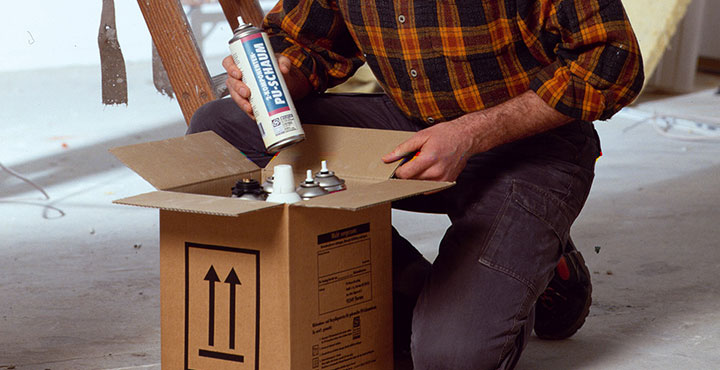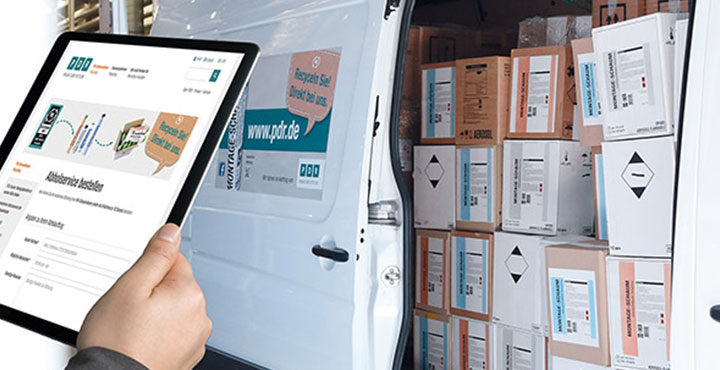
Recycling – a new lease of life for construction foam cans
"Cradle to cradle" is the aim of modern recycling systems.
This means that, ideally, a product will be used over and over again - although perhaps in a different form. This vision is already reality for the 25 million PU foam cans used in Germany every year. A spent construction foam can is recycled to 95%; 80% of this in materials. This is made possible by the PDR industry solution.
PDR Recycling GmbH + Co KG — Products via Recycling

As early as 1993 the European manufacturers of PU foam cans set up an exemplary return and recycling solution for spent assembly foam cans in collaboration with PDR. Today, PDR is a sought-after recycling specialist for materials recycling of used products and production residues. It all started with the recycling of PU foam cans.
How PU foam cans are recycled

The only system for recycling PU foam cans in the world is located at the site in Thurnau (Upper Franconia). Both the packaging and also the fluid residual contents can be recovered here.
This recycling system chops the assembly foam cans mechanically without oxygen and the fluid residues and metal parts (aluminium and tin plate) fall into a solvent bath. Here, a washing screw removes the metal parts and washes them. This is followed by further washing and drying stages. The metal filter sorts the cleaned and dried aluminium and tinplate.
The PU solvent mix that is created runs through a filter several times to separate the PU and solvent again. The solvent is added to a cycle for reuse in the next washing stages. The propellants are suctioned off and liquefied under pressure. The plastic caps are ground into granulate and used to make plastics.
Recycling of PU foam cans explained in simple terms.
A humorous explanation of the returns and recycling system for spent PU foam cans:
New products from old construction foam cans
In this way, PDR recycles 95 percent of the returned cans. 80% of this in materials. A series of new products is created that are returned to the raw material cycle.
PREPUR®
is the prepolymer, recovered from PU foam cans. It is reused in various polyurethane applications, such as adhesives, lacquers, filling materials and binding agents, and is also added when producing new foams - this closes the cycle.
PREMOD®
is a blend of PREPUR® and MDI. As agreed with the customers, various mix ratios are possible depending on the specific purpose.
TRIGAS®
is the propellant, that PDR recovers from the PU foam cans. The aerosol industry uses the fluid gas mix for technical aerosol products and cleaner sprays.
The ground plastic PE/PP
is produced from the recycled caps of the spent PU foam cans. This is a colourful mix of PE/PP plastics and is used to make other plastics.
Also, there are scraps of tin plate and aluminium from the packaging material of the assembly foam cans. Both fractions are sold to the metal-working industry where they are smelted again.
 After recycling, new products are created from old foam cans.
After recycling, new products are created from old foam cans.
Do you have any empty or spent PU foam cans?
Find out here how you can recycle PU foam cans free-of-charge.
Is it worthwhile recycling PU foam cans?

Interview with Dr. Thomas Hillebrand, CEO of PDR
It is possible to recycle about 80 percent of the material of a spent PU foam, and therefore return them to the economic cycle as a raw material or product. Nevertheless, resources are also required for the recycling and transportation processes. The PU-Foam Info Centre therefore decided to ask CEO of PDR Dr. Thomas Hillebrand whether the recycling gains are actually higher than the energy required for this process.
1 Mr Hillebrand, spent PU foam cans don’t really weigh that much. Doesn’t it take much more energy to collect the cans from the users than simply throw them away?
This is a question we have of course asked ourselves. Recycling is only worthwhile, when the produced raw materials and the amount of energy required outweigh the costs of simply collecting and treating the waste. This is why we had an ecological balance sheet of this process drawn up ten years ago. The result was very clear. Recovering technical gases and the prepolymer - basically the packaging including the contents - if of much greater benefit for the environment than if just the packaging, i.e. the can itself were recycled.
2 And what happens, if you simply throw the can away?
I can only say that to do so is a criminal offence. The legislator has classified spent construction foam cans as hazardous waste. Which means they may not be simply thrown away, they must be treated as hazardous waste.
3 Trade professionals need to ensure compliance with a large number of laws and regulations. Do you really think that we can expect trade professionals to put in the effort required to collect different types of waste separately?

We can safely assume that, today, most of the working population have grown up separating waste, or have at least been doing so for the past 20 years, be it at home or at work The idea as certainly caught on.
If the service is right and the trade professionals can also see that their waste is really being used to make new products, they will be willing to separate their waste. Any trade professionals who want to see how our recycling systems work, can read the in-depth explanation of the process on our website.
4 What do you think of the idea of creating one central collection bin for all problematic waste that can then be sent to specific recycling processes?
It’s rubbish, no pun intended! There is a very real risk, especially where hazardous waste is concerned, that different waste fractions could mutually contaminate one another. This means that less materials can be recycled. And I don’t even want to think about the mutual chemical interactions that various hazardous materials may have.
5 Do you believe that the sector’s solution for recycling PU foam cans could be transferred to other hazardous waste?

I certainly believe that this is possible. It works with batteries and waste oil for example. One of the biggest challenges is to bring the competitors in a sector together and motivate them to find a common solution for their products. The larger the amount of waste, the more efficient the recycling process can be. Often, there are psychological barriers that need to be overcome.
6 Like every other company, a recycling company also leaves behind its own ecological footprint. What does PDR do to keep its footprint as small as possible?
We are like a lot of other environmentally-aware companies in this respect. We continuously work on reducing the amount of resources we consume. For instance, we are continuously optimising the collection process to ensure that as many spent cans are collected as possible per trip. We also check our own systems to see where we can save energy and resources. In 2022, PDR was certified to DIN EN 50001 to speed up this process. This energy management certificate obligates us to consume fewer resources every year. This is a continuous improvement process.

![[Translate to Englisch:] Sicher arbeiten mit PU [Translate to Englisch:] Sicher arbeiten mit PU](/fileadmin/PU-Schaum-Center/PU-Schaum_in_der_Praxis/img_sicher_arbeiten_mit_PU-Schaum.jpg)
![[Translate to Englisch:] Bauschaum [Translate to Englisch:] Bauschaum](/fileadmin/PU-Schaum-Center/PU-Schaumarten/img_PU-Schaumarten_bauschaum_produkt_viele_namen.png)
![[Translate to Englisch:] FAQ PU-Schaum [Translate to Englisch:] FAQ PU-Schaum](/fileadmin/PU-Schaum-Center/PU-Schaum_in_der_Praxis/img_Praxis_FAQ.jpg)

